Apple's 2010 MacBook Air (11 & 13 inch) Thoroughly Reviewed
by Anand Lal Shimpi on October 26, 2010 10:08 PM EST- Posted in
- Mac
- Apple
- MacBook Air
- Laptops
The 11-inch as a Windows Notebook
As a follow-up to our Nvidia 320M/MacBook Pro 13 article last week, I’ve been running our Windows test suite on the MacBook Air 11”. I, like Anand, have the lowest end 11”er, with 2GB memory and the 64GB SSD. This makes installing Windows an interesting proposition since after the two OS installs, you’ve got right around 30GB of free disk space to work with. My suggestion - if you plan on installing Windows and dual booting often, save yourself the headache and get the 128GB model.
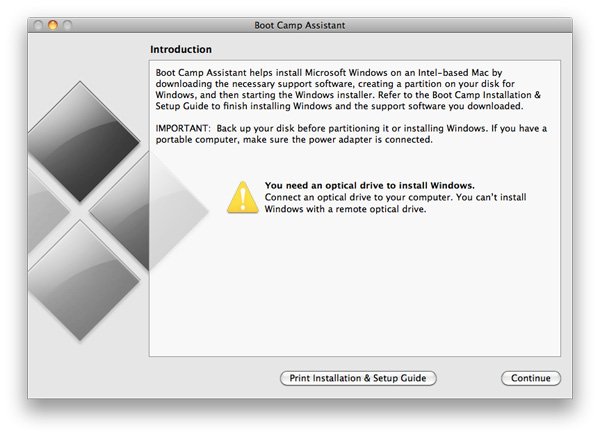
The other quirk with putting Windows on the Air is that it must be done with a USB optical drive - no hard drive/thumb drive installs. Interestingly, my external optical drive wasn’t recognized as a bootable drive, so I had to run out and grab an Apple SuperDrive. Apple says that you just need an external DVD drive, without specifying the MacBook Air SuperDrive, but your mileage may vary.
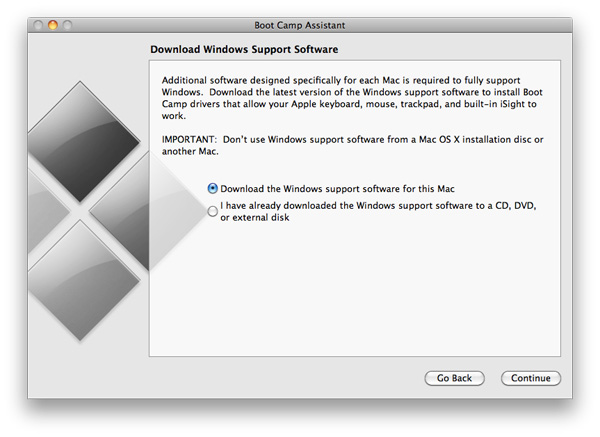
Boot Camp Drivers are now downloaded from Apple's servers prior to the Windows installation
With the Windows install out of the way, we were free to test the living daylights out of it, and that we most certainly did. The 11” Air has the same 1.4GHz Core 2 Duo SU9400 as the similarly thin Dell Adamo 13. Months after we move to Arrandale ULV, leave it to Apple to bring the good old CULV platform back to relevance. As expected, Cinebench and the x264 encoding test gave us results around the same level as the Adamo and the rest of the old CULV gang. Versus the 13” MacBook Pro, you’re looking at roughly a 40% decrease in the CPU compute-heavy benchmarks, roughly equivalent to the reduction in clock speed from the 2.4GHz Pro to the 1.4GHz Air. Arrandale ULV notebooks, such as the Alienware M11x and its Core i7-620UM, are another matter entirely, with the newer architecture posting numbers nearly doubling the Air’s Core 2 processor.
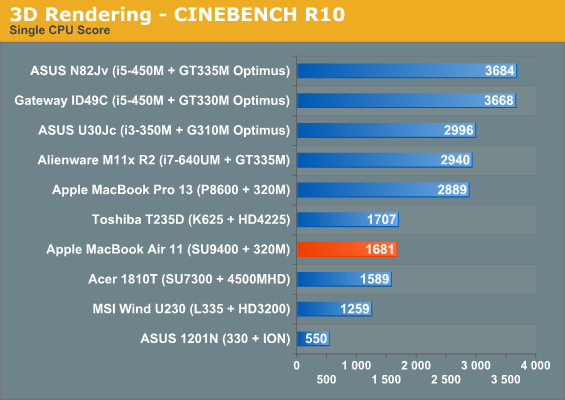
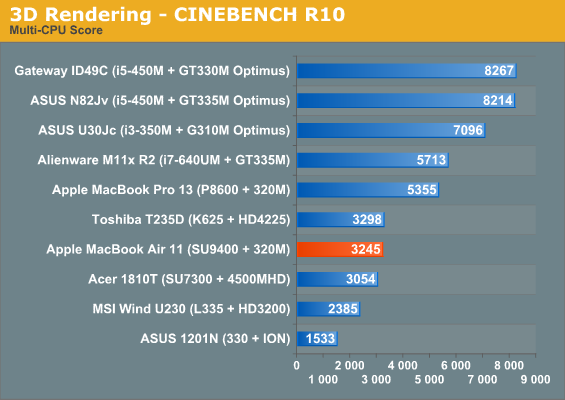
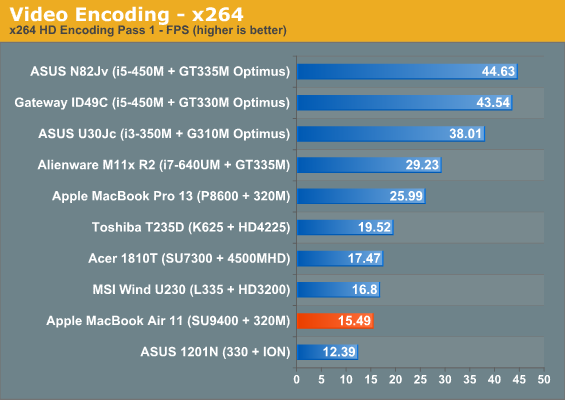

The gaming benchmarks get a bit more interesting. We’re looking at the same GT 216-derived GeForce 320M that was in the MacBook Pro 13, with the same 450MHz core and 950MHz shader clocks. Based on the performance we saw out of the Pro 13, we know that the Air, even in 11” form, can still hold its own in games.
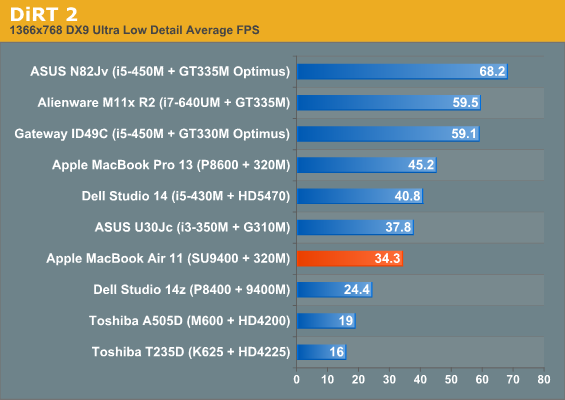
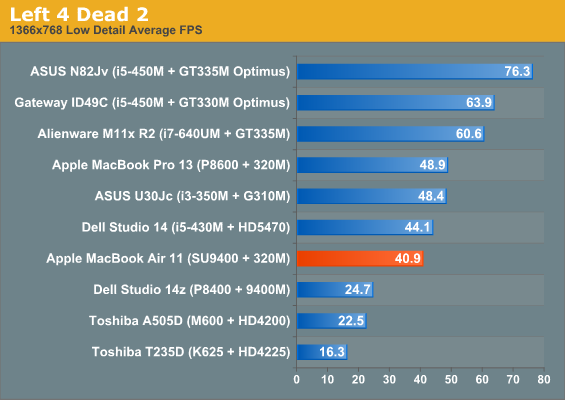
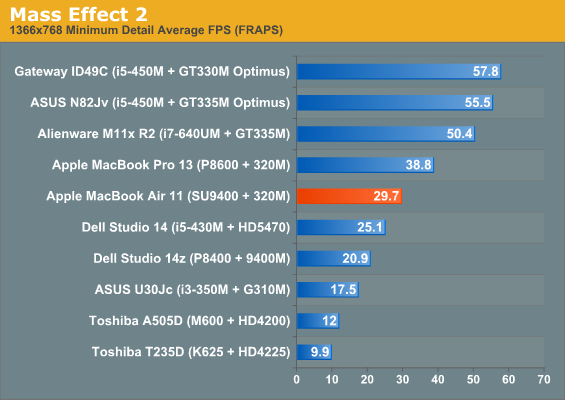
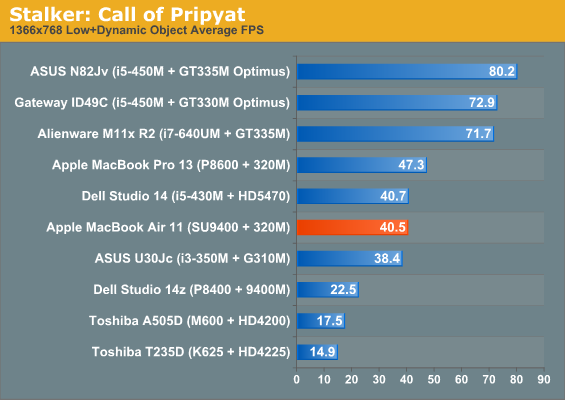
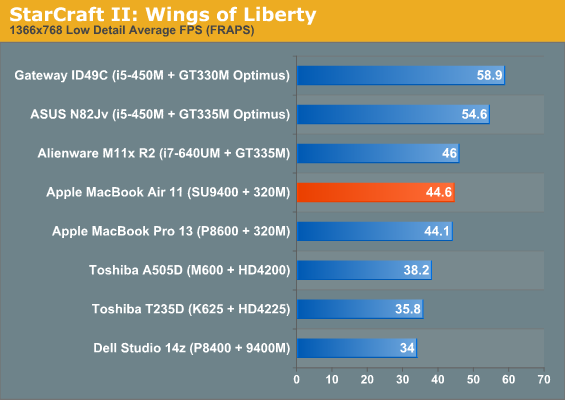
At low detail settings, the Air is pretty consistently 20% slower than the Pro 13, except in SC2, where they were roughly equal. Given that the GPU is identical and that both are using 256MB of the system’s DDR3 1066 memory, it is likely that the 1.4GHz Core 2 Duo is slow enough to put a bottleneck on gaming performance. It’s still a ways ahead of the ASUS Core i3/G 310M combo, and all of our games are playable at native resolution.
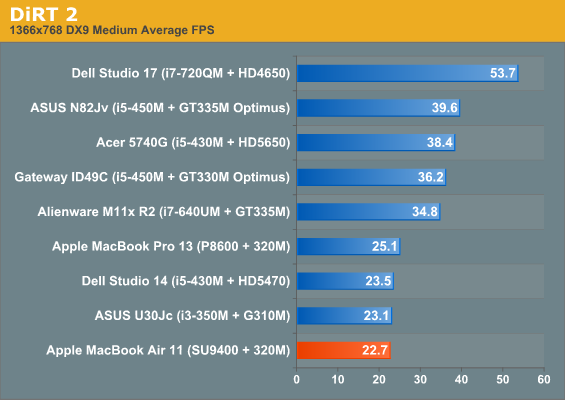
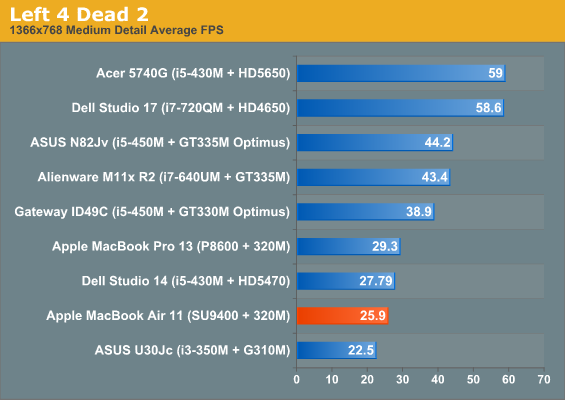
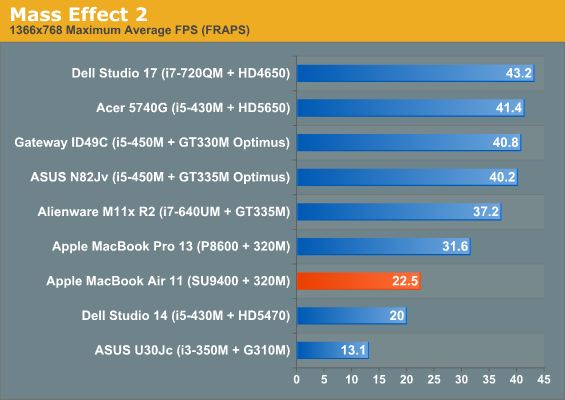
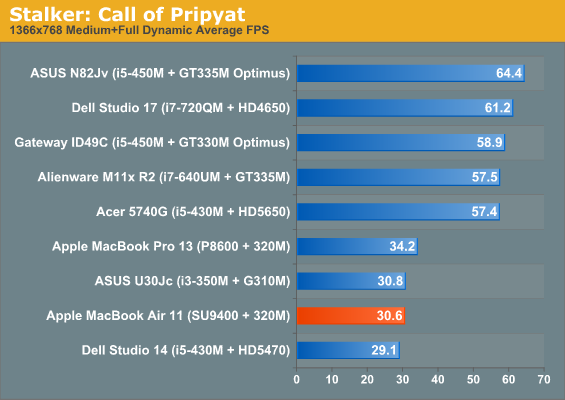
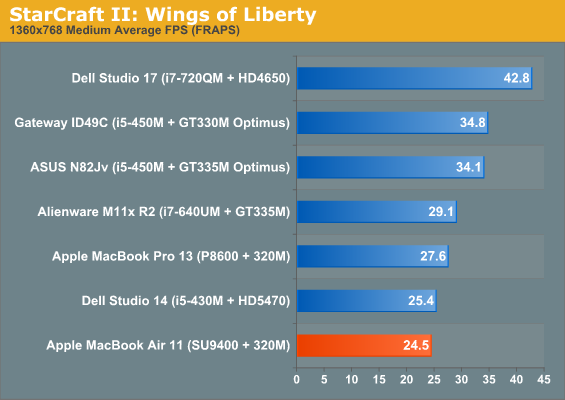
At medium settings though, the Air starts to fall off a bit. Where the MBP13 was borderline-playable, always between the 25-35 fps range, the Air is about 10% behind and makes it to the magical 30fps mark in STALKER, but nothing else. DiRT 2, Left 4Dead 2, Mass Effect 2, and StarCraft II all ended up between 22 and 26 fps, still faster than the G 310M, but not quite playable. Another interesting concern during gaming is heat. The Air isn’t the coolest notebook in the world, with idle temps hovering around 50C, but while running the gaming tests, I saw GPU temps rise up into the 70s. Nothing too alarming, but still pretty toasty and more than enough to get the fans spinning to the max.
But let’s put this all in perspective. This isn’t about just an 11.6” notebook that can game - the 11.6” M11x is the fastest gaming notebook under 5lbs, but even then it’s still a full two times heavier than the MB Air 11. The Air 11 shoehorns quite a bit of power into one of the smallest form factors on the market. Having a GT 216 core in an enclosure this small and being able to run these games at 40 fps at native resolution is definitely very impressive.










185 Comments
View All Comments
VanHoward - Wednesday, October 27, 2010 - link
Instead of "jives with" should be "jibes with" ...Exelius - Wednesday, October 27, 2010 - link
I'm a huge Apple fan - but I'm just not drinking the kool-aid on this one.I have a 15" MBP and it's really not that bad to carry around. It also gets like 5-8 hours of battery life (3-4 with VMWare running) and it runs Windows 7 under VMware very well with 8 GB of RAM. I've never considered portability an issue and while it's an expensive machine, I don't think you'd own an MBA. I doubt the MBA would have nearly that type of battery life under VMWare.
The iPad seems like a better form factor for the "couch computer" (i.e. looking up shit on IMDB or googling something to settle an argument while watching football.)
IMO the MBA seems like a poor man's MBP. i.e. for students looking for a cheaper computer; the "super-thin" part seems almost like a gimmick to convince people it's a premium product. Really, the only drawback of the 15" MBP (even the lowest-specced one) is the price.
joe_dude - Wednesday, October 27, 2010 - link
The thing's hardly faster than my Ion netbook. There will be lots of thin designs coming out like what Intel showed at Computex. Core 2's two generations behind.For now, I think the Acer TimeLineX 3820TG is still the best ultraportable laptop (certainly the fastest anyway).
zsero - Wednesday, October 27, 2010 - link
As for an alternative for sub 5 lbs powerful laptops and as for the M11x being fast: I am typing this line on a Acer TimelineX 3820TG with 450M and switchable HD5650, which is on a totally different level than either the MBA or the Dell (while being half the price).- 3.9 lbs
- it can do 9000-10000 points in 3dmark06 easily with a little bit of raised clocks (one click in AMD GPU tool). In games it's even faster, as the ATI cards are much better in real games than in benchmarks.
- if you are lucky, you can overclock CPU to 3.3 Ghz (or swap to a 580M and OC-it to 3.8 Ghz, with sub-75C temperatures!)
- and easily do 6-8 hours while web surfing
- has dual fan / dual heatpipe cooling
Other than that, it has the most horrible keyboard I have ever seen, with a cheap AUO screen, noisy mic and poor warranty service and a gazillion of running applications, including two real-time virus scanners on the factory install. But a review would be really interesting to see! I seriously think the 3820TG with HD5650 is without alternative in the powerful but portable notebooks, if possible, please make a review about it! (in North America, I think it's only available with 370M processor, while in Asia they sell it with anything up to 640M).
khimera2000 - Wednesday, October 27, 2010 - link
Intresting system, but i wouldent use it. the keyboard looks to have flex under light loads, making me think that although it looks great on the outside the inside might of had to make some structual sacrifices for the bigger specs, not to mention that the lack of a backlit keyboard would make it more inconveniant compared to what i have now.But it does like they are trying to improve there build quality, its just not to the point that i would like.
As nice as the specs are, i just cant bring myself to trust there build quality just yet, however it does look like there at least trying to improve so who knows perhaps there will be an acer on my list of potentials the next time im do for a notebook upgrade.
as for comparison to the air... i think there oppisets in some respects. the air's performance although weak at best can still fit in nearly any bag making it conveniant to find a place to stow it for those who have bags full of books and junk, where as the acer trys to push for a more heavy multimedia experiance with a good compact form facter and a extended battery.
lemonadesoda - Wednesday, October 27, 2010 - link
1/ SD card reader2/ mic on front for skype/VoIP
The 11" netbook would be a absolute winner (and an order of magnitude upgrade for people using Atom netbooks) . But why did they miss the SD card reader? This is so obvious, and a determining feature what makes one brand/model of netbook a winner over another brand/model. Such a simple and cheap port. Even the iPad has an SD card reader!
And what on earth are they doing putting the mic on the side like that? While it *might* be OK when sitting indoors at a tidy desk without other ambient noise, it certainly is not clever in most "real world" situations.
I would love to replace my ever-so-slightly too noisy and underpowered (but magnificent screen and full of ports) SONY W11 netbook. But no, not until Apple fix the mic location and provide an SD slot.
(I use SD slot for camera - saving local or uploading to fileserver/website, for camcorder - and immediate playback of material recorded, for old-fashioned mailing of data/documents, for a TASCAM HQ digital audio recorder, and for file transfer with colleagues and for file backup when out of the office, I need highest possible robust mic for indoor and outdoor skype/VoIP where my office telephone is forwarded to my laptop through SIP )
These two points may seem like tiny features, but I think for many people they are showstoppers.
johnspierce - Wednesday, October 27, 2010 - link
I'm not sure why everyone thinks an SD card slot is a "must have". For one thing, there are still quite a few cameras that *don't* use SD cards (like virtually any high-end DSLR) and putting a technology in your laptop that might not even be viable in 3-5 years is not exactly a good idea. Buy a 9-in-1 card reader. They are like $20. They are about the size of a deck of cards and can handle almost any type of flash.I would MUCH rather have a 3.0 USB than a SD card slot -- infinitely more useful.
kmmatney - Wednesday, October 27, 2010 - link
SD slots are useful for permanent storage. I have an 80GB SSD in my Dell Inspiron 9400 laptop, but needed a little more storage. So I just keep a 32 GB card in the SD slot, and it gave me enough room for everything I need. I use it mainly for documents, presentations, and backups of important work from teh SSD. It only sticks out about 2 mm, so I can keep it on all the time. I've even run VMware images from it, and it wasn't too bad.I agree that a USB 3.0 slot is useful as well, but wouldn't want to lose the SD slot - its like having a second, easily removable, hard drive.
khimera2000 - Wednesday, October 27, 2010 - link
I see it as a replacemenct for the optical drive, since its also used in cameras, video recorders, and ebook readers (i have an SLR that uses these and a ebook) it makes them alot more conveniant since most notebooks come with the slot already. it puts the macbook at a disadvantage becaus now people have to carry around a card reader that would not be neaded on other notebooks.It would be such an inconveniance if i had to drag around a reader with me, and since alot of apple users do photo and video editing it looks like a bad oversight not being able to transfer images and videos without extra required hardware.
Stuka87 - Wednesday, October 27, 2010 - link
So I am posting late here. I read this last night, but was too tired to respond.So now a lot has already been said. But here is one thing that keeps boggling me.
WHY do people keep calling this a Netbook when it clearly *IS NOT*. The 11.6" MBA is an ultraportable. In line with other ultraportables out there. Its not a cheap piece of plastic with a laughable screen, keyboard, graphics, or atom processor. The benchmarks clearly show this machine to run circles around an atom.
And if you compare it to similar machines of weight, size, and speed its not far off the mark from a price concern either.
Is it a perfect machine, no... But it looks like it will fill the gap that has been missing from the Apple product line since the demise of the 12" PowerBook.